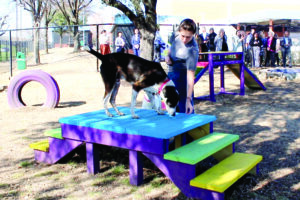By Becky Deo
Park Place team members came together to build a Sensory Garden for the SPCA of Texas’ Animal Care Center in Dallas providing dogs with an environment allowing them to use their natural senses. Employees from Park Place Dealerships volunteered to build a sand pit, swimming pool, rosemary plantings and agility obstacles for the shelter dogs. The company’s generous “Volunteer Days” program allowed staff members to take two paid days off and donate their time to build the Sensory Garden.

Photo courtesy of Park Place Dealerships
Dr. Valerie Tynes — one of less than 10 vets in the country that have board certifications in behavior and welfare — discussed why the Sensory Garden is important in the shelter setting; how the Garden encourages dogs to interact with their surroundings; how the agility obstacles relieve stress for overactive dogs as they await a loving, forever home; and how the Garden’s different textures, scents and materials stimulate a dog’s brain, activate his/her natural canine instincts, and build confidence as well as provide mental and physical challenges.
“Enrichment is what we use to improve our dog’s quality of life by providing them things in their environment that stimulate them mentally and physically,” said Dr. Tynes, SPCA of Texas Shelter veterinary behaviorist. “Sensory stimuli are just one part of this. Olfactory enrichment is perceived to be especially valuable because of the dog’s excellent sense of smell and the role that olfactory communication plays in their daily lives.
“Ultimately, when you provide environmental enrichment, you are attempting to give an animal the ability to utilize as many of its natural behaviors as you possibly can. Olfactory enrichment is good at doing that, simply because dogs love using their nose to investigate their world,” she added.
“We use the Sensory Garden to do behavior modification for high arousal, jumpy, mouthy dogs,” said SPCA of Texas Behavior Program Manager Rebecca Woodward. “Essentially, what we started doing was creating a program for these dogs using agility because of this garden.
“Once we started doing that, we were able to decompress the dogs and they were getting adopted more quickly than before. It’s a really good outlet for those high energy, kennel stressed dogs,” Woodward added.
SPCA of Texas is the leading animal welfare organization in North Texas. Founded in 1938, the non-profit operates two shelters, two spay/neuter clinics, two mobile spay/neuter and wellness vehicles, one mobile adoptions vehicle and an animal rescue center, all located in Dallas and Ellis Counties, and maintains a team of animal cruelty investigators who respond to thousands of calls in North Texas counties. The organization does not euthanize animals for time or space. SPCA of Texas is dedicated to providing every animal exceptional care and a loving home. Visit spca.org for more information.
